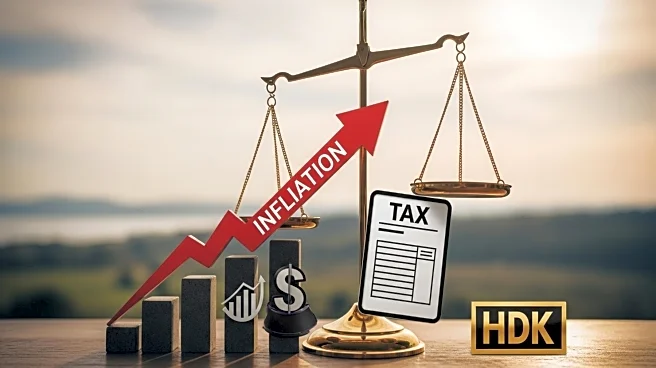What's Happening?
The IRS has announced changes to the capital gains tax brackets for the 2026 tax year, allowing individuals and married couples to earn more while potentially paying less in taxes on investment profits. For 2026, individuals with taxable income up to $49,450 and married couples filing jointly with incomes up to $98,900 will qualify for a 0% tax rate on long-term capital gains. Those earning up to $545,500 individually or $613,700 jointly will be taxed at a 15% rate, while incomes exceeding these amounts will incur a 20% tax rate. These adjustments are part of a broader set of tax rule changes aimed at providing more favorable conditions for taxpayers. The IRS uses taxable income, calculated by subtracting deductions from gross income, to determine eligibility for these rates. Investors are encouraged to consider their tax strategies for 2025, as the last quarter is a critical period for tax planning, including strategies like tax-loss harvesting.
Why It's Important?
The adjustment in capital gains tax brackets is significant for investors and financial planners, as it provides an opportunity to optimize tax liabilities on investment profits. By increasing the income thresholds for lower tax rates, the IRS is effectively allowing taxpayers to retain more of their investment earnings, which could encourage more investment activity. This change may benefit individuals and families with substantial investment portfolios, potentially leading to increased financial planning and investment strategies. The broader economic impact could include increased market participation and liquidity, as investors seek to maximize their returns under the new tax conditions. Additionally, the changes may influence decisions on asset sales and portfolio adjustments, as investors aim to align their strategies with the new tax landscape.
What's Next?
Investors and financial planners will likely review their portfolios and tax strategies in light of the new IRS rules. The last quarter of 2025 is a crucial time for tax planning, as individuals can still make adjustments to their investment holdings to optimize their tax positions before the end of the year. Strategies such as tax-loss harvesting, where underperforming investments are sold to offset gains, may become more prevalent. Financial professionals will play a key role in advising clients on how to navigate these changes and avoid potential pitfalls in tax planning. The IRS's adjustments may also prompt discussions among policymakers and stakeholders about further tax reforms and their implications for economic growth and investment behavior.
Beyond the Headlines
The IRS's decision to adjust capital gains tax brackets may have deeper implications for tax policy and economic equity. By allowing higher income thresholds for lower tax rates, the changes could be seen as a move to support middle and upper-middle-class investors, potentially sparking debates about tax fairness and the distribution of tax benefits. Additionally, the focus on long-term capital gains may encourage more sustainable investment practices, as investors are incentivized to hold assets for longer periods to benefit from favorable tax rates. This could lead to shifts in investment strategies and market dynamics, with potential impacts on asset prices and market volatility.










